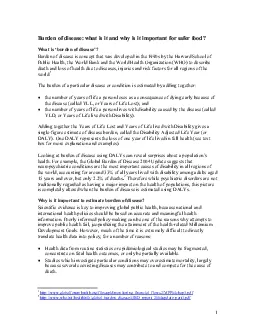

Adding together the Years of Life Lost and Years of Life lived with Disability gives a singlefigure estimate of disease burdWhy is it important to estimate burden of disease Scientific evidence is ke ID: 885040
Download Pdf The PPT/PDF document "the number of years of life a person liv..." is the property of its rightful owner. Permission is granted to download and print the materials on this web site for personal, non-commercial use only, and to display it on your personal computer provided you do not modify the materials and that you retain all copyright notices contained in the materials. By downloading content from our website, you accept the terms of this agreement.
1 the number of years of life a person liv
the number of years of life a person lives with disability caused by the disease (called YLD, or Years of Life lived with Disability). Adding together the Years of Life Lost and Years of Life lived with Disability gives a single-figure estimate of disease burd Why is it important to estimate burden of disease? Scientific evidence is key to improving global public health, because national and Health data from routine statistics or epidemiological studies may be fragmented, concentrate on fatal health outcomes, or only be partially available. Studies which investigate particular conditions may overestimate mortality, largely because several coexisting diseases may c 1 http://www.globalforumhealth.org/filesupld/monitoring_financial_flows2/MFF04 Text box: examples of DALYs for diseases with a link to unsafe food using data from WHO Global Burden of Disease 2004 update5 DALYs, YLL and YLD for intestinal nematode infections (World), epilepsy (WHO African Region), and diarrheal diseases (WHO South East Asian Region)0510152025YLL
2 andYLDDALYsYLL andYLDDALYsYLL andYLDDALY
andYLDDALYsYLL andYLDDALYsYLL andYLDDALYs SEARO:DiarrhealdiseasesAFRO: EpilepsyWorld: intestinalnematodeinfections321 Person-years (millions) YLL YLD DALYs Source: WHO Global Burden of Disease (GBD) 2004 1. Intestinal nematode infections Eating food that is infected with the eggs of intestinal nematodes (more commonly known as ‘worms’) is the cause of much illness across the world. The chart shows that while not many people die from worm- infection (represented by a small number of YLL), most of the overall burden of disease from worm infection (as shown by the number of DALYs) comes from a high degree of disability (high number of YLDs). 2. Epilepsy The picture is slightly different for epilepsy. There are different causes of epilepsy, one of which occurs through eating food infected with the parasite Taenia solium. Infection with this parasite can lead to neurocysticercosis, which is an entirely preventable form of epilepsy. The chart shows the DALYs, YLL and YLD associated with all causes of epilepsy for the WHO African region (unfortunately there are no data cu
3 rrently available on the burden of disea
rrently available on the burden of disease solely from Taenia solium). The data show that, unlike infection with worms, epilepsy leads to approximately equal amounts of YLL and YLD. 3. Diarrheal diseases As the chart shows, diarrheal diseases are a major cause of burden of disease in the WHO South East Asia region (as shown by the high number of DALYs). Unfortunately there are no data currently available that estimate the total burden of disease from diarrhoea related to unsafe food, but studies from developed countries show that foodborne diseases account for a significant proportion of diarrhoeal disease. The chart shows that the high number of DALYs from diarrheal disease is mostly a result of the high YLL. Put more simply, diarrhoea causes a great number of deaths, particularly in babies and young children. This, however, is also a reflection of the fact that the complications arising from diarrheal disease have never been quantified. 5 http://www.who.int/healthinfo/global_burden_disease/2004_report_update/en/index.html